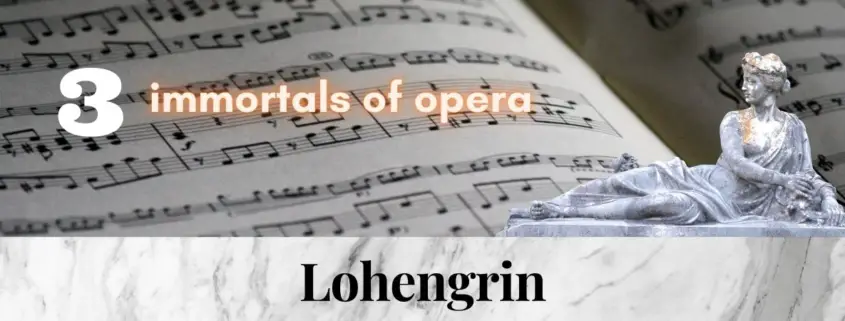3 immortal pieces from the opera LOHENGRIN by Wagner- with the best interpretations from YouTube (Hits, Best of)
For a long time, Lohengrin was Richard Wagner’s most frequently performed work. King Ludwig II saw it in Munich in 1857 and left the theatre in tears. This experience should not only change his, but also Wagner’s life.
Elsa’s dream
Elsa is accused of murder. Instead of defending herself, Elsa tells of her grief over the death of her brother and of a dream that a knight will appear who will fight for her and prove her innocence.
After a short beginning of flutes and strings the Gralmotiv appears and Elsa begins her dream with a pure and luminous voice. The slow tempo intensifies the feeling of loneliness. It is followed by a great crescendo beginning with “da drang aus meinem Stöhnen”. Elsa sinks to sleep and a beautiful orchestral transition leads into the Grail motif. And her vision begins…
Gundula Janowitz’s interpretation of this aria is simply great. We hear in this aria the purity, vulnerability and confidence of Elsa. Her crescendo is breathtaking and the ending is outworldly.
Einsam in trüben Tagen – Janowitz
In the bedroom – the famous wedding song
Elsa and Lohengrin are taken to the bridal chamber. They are alone with each other for the first time.
At this point Wagner’s famous wedding march can be heard.
Treulich geführt – Burgos
Lohengrins final appearance – the Grail narrative
The ceremonial act is abruptly interrupted when Friedrich’s body is carried in and Elsa appears deeply saddened. She is followed by Lohengrin who reports to the king that he will not lead the army. He tells that Elsa has broken her oath, and he solemnly proclaims his origin to all. He is a knight of the Holy Grail, coming from Montsalvat Castle. His father is Parzival. He himself is his knight, called Lohengrin. He was sent out by the Grail to fight evil and defend virtue.
Similar to the Tannhäuser with the Roman tale of the last act, the tenor must sing his most important section at the end of the opera. This means that the singer must have sufficient vocal power to bring this section to a climax of the evening. In Lohengrin, the task is “easier” than in Tannhäuser since the Grail narration (“In fernem Land”) and his farewell (“Mein lieber Schwan”) are lyrical pieces with an almost bel canto character, while the Roman Tale requires a dramatic voice.
Lohengrin’s story is composed in a solemn, measured tempo. The voice must be dignified, yet light, brilliant and mysterious, far from being pathetic or heroic. With a solemn voice he sings the annual miracle «Alljährlich naht vom Himmel eine Taube um neu zu stärken seine Wunderkraft. Es heisst der Gral» (“Every year a dove approaches from heaven to strengthen its miracle power anew. It is called the Grail)”. A beautiful soft forte in A shines over the buzzing sound of the violins. The high tessitura of the following passage keeps the drama and solemnity high. It is a demanding passage for the tenor, who has to keep up the vocal power without overexerting the voice. At the end Lohengrin reveals his name. Now the voice changes, it becomes magnificent, glorious and heroic, by no means hollow, but noble. It is the highlight and key of the opera.
Then Lohengrin tells of his origins, the orchestra shines in radiant A major. It is a bright, high key that announces the heavenly spheres of the Grail. High shimmering violins convey a feeling of an etheric rapture.
“A few weeks before his death, Björling sang the story of the Grail for the first and last time in public. Even if the Swedish language is not necessarily suitable for the Lohengrin, even if it is still at the beginning in terms of interpretation, is sung too burschikos and also contains a musical error – here it is, the ideal Lohengrin voice. Björlings has perhaps been the greatest loss to Wagner’s singing imaginable: Distance and distance from the world and painfully tinted sensuality”. (Fischer, great voices)
In fernem Land (1) – Björling







Leave a Reply
Want to join the discussion?Feel free to contribute!